Despite that change, one thing has remained the same in my mind: Successful cold outreach is built on strategy, not on chance.
In this article, I’m going to look at two of the main outreach methods sales pros rely on to keep pipelines full. If you’re torn between cold email vs cold call outreach, I hope this deep dive will give you a better idea of why and when to use each one.
Table of Contents
- Cold Email vs. Cold Call
- Pros and Cons of Cold Emailing
- Pros and Cons of Cold Calling
- How to Decide Between Emailing & Calling
- Cold Call vs. Email Statistics
- Which is more successful: Cold emailing or cold calling?
- Cold Calling Tools
- Cold Emailing Tools
Cold Email vs. Cold Call
Cold emails and cold calls are both effective prospecting tactics in their own ways. The difference between the two often comes down to volume and convenience versus directness and immediacy.
At a high level, cold emails are generally easier to scale, and they can be less time-consuming at higher volume than cold calls, whereas cold calls are more direct and have the advantage of speeding up (dis)qualification.
Let’s take a closer look at each one, and I’ll try to shed a more detailed light on the pros and cons starting with email.
Pros and Cons of Cold Emailing
Cold emailing can be a powerful outbound sales tactic if done right. As someone who has sent thousands of cold emails over the years, I’ve experienced both the highs (new deals closed from a single well-timed email) and the lows (my emails disappearing into the void of spam folders).
Let’s examine the pros and cons of cold emailing, and I’ll share some firsthand tips for making the most of this method.
Pro: You can scale your outreach efficiently.
One major advantage of cold emailing is the ability to reach many prospects at scale with relatively little effort. With the right tools, a single rep can send personalized emails to dozens or hundreds of contacts in a day.
For example, I often use HubSpot’s email sequence tool to automate follow-ups — if a prospect doesn’t reply to my first email, they’ll get a second touch a few days later automatically. This scalable nature of email is hard to beat, but it’s important to be careful: Scale should never come at the cost of authenticity. Each message should feel like it’s just for that specific recipient.
If you need some ideas about where to start your messaging, check out this list of Sales Hub Email Templates for a good foundation.
Pro: Prospects can respond on their own time.
Another benefit of cold emails is that they let the prospect respond on their terms. I’ve had prospects reply to my cold emails at 10 PM or on the weekend — times I would never have called them.
By using email, you respect the prospect’s schedule and give them more control, which often leads to more thoughtful replies instead of knee-jerk negative reactions when they feel ambushed. The key is to make your email compelling enough that they want to respond when they have time.
Pro tip: Try ending emails with a question as much as possible. This kind of call-to-action (CTA) invites a response without cornering them into a hard commitment, and it fits the asynchronous nature of email.
Pro: You can include more detail and resources.
Cold emails allow you to provide richer information upfront than you can in a phone call. In an email, you can concisely explain your value proposition and also link to supporting content.
For instance, when I email a prospect, I often include a link to a short case study or a client success story relevant to their company and industry. I might bullet out a few key benefits of our product, or even embed a chart or infographic if it strengthens the message.
Emails let you craft a narrative and ensure the prospect has all the context they need to understand your offering. Just be careful not to write a novel — brevity still wins.
Pro: Email is easy to track and optimize.
When you send cold emails, you gain access to a wealth of data on engagement. Email tracking software can tell you if a prospect opened your message, what time they looked at it, whether they clicked any links, and more. These metrics are gold for a salesperson.
I’ll give a personal example: I once sent a cold email to a CEO and saw through HubSpot’s email tracking that he opened it five times and clicked the pricing link inside. He hadn’t responded, but that was a strong buying signal — so I called and had a meaningful conversation.
With cold calls alone, you’d never have that level of detail. Over time, data-driven optimization can significantly improve your cold email success.
Con: It’s easy for a cold email to get lost or ignored.
Now for the downsides of cold emailing. The very convenience that makes email attractive also means your outreach can be easily ignored. Prospects receive a flood of emails daily — newsletters, promotions, internal messages — and an email from someone they don’t know can quickly blend into the noise.
If I’m focused too much on scale and personalization suffers, I might email 100 prospects and get only a handful of replies. If I invest sufficient time, I’ll usually see open rates around 30% and 10-15% replies, but this scenario generally involves sacrificing the scale advantage we first touched on.
Con: Deliverability and spam filters pose challenges.
Even worse than being ignored is when your cold emails never reach the inbox at all. Spam filters and email deliverability issues are a constant concern in cold outreach. If your email looks too generic, contains spam-trigger words, or you send a high volume from a new email address, there’s a risk your messages get flagged by email service providers.
I’ve learned this the hard way several times. It can be a big blow to morale to hear crickets for a few days, only to run a deliverability check and realize that a significant portion of your thoughtful, carefully curated outreach has gone unseen.
Pro tip: Check deliverability at least once a week using one of the many free tools available.
Con: There's no real-time feedback or immediate course-correction.
When cold calls connect, you get instant feedback — positive or negative — which lets you adapt quickly. In a cold email, however, you’re essentially leaving a voicemail in text form and waiting to see if it resonates. This lack of real-time interaction means it’s harder to clarify points or handle objections.
If a prospect is confused by something in your email, they probably won’t bother to ask for clarification; they’ll just ignore it. Or if they’re interested but have a specific question, they have to make the effort to reply and ask. And you already know that many won’t.
Con: It requires strong writing skills and research.
Succeeding with cold email in a sea of competition requires standout writing and research abilities. Crafting a message that not only avoids spam filters but also genuinely engages a stranger is no small feat. You need a catchy subject line, a personalized intro, a clear value proposition, and a call-to-action — all in just a few short paragraphs.
Not everyone on a sales team will naturally have copywriting chops, so it often takes training and practice to get good at cold email writing. Additionally, doing research on each prospect (like mentioning a recent company accomplishment or a quote from them in an article) can dramatically improve response rates, but that time adds up.
Despite these cons, cold emailing is a staple of modern sales for good reason. The key is to maximize the pros — scalability, convenience, informative metrics — while mitigating the cons through personalization, persistence, and continuous improvement of your tactics. But how does cold emailing stack up against cold calling? Let’s explore that next.
Pros and Cons of Cold Calling
Pro: Cold calls can be more personal.
A cold call can be more personal than a cold email, and a voice on the other end of the line adds a human touch that a lot of remote-first, asynchronous business is lacking these days.
Calls allow for a dialogue that email simply can’t match, helping you learn more about a prospect, deal with objections quickly, and then adjust your strategy in real-time to fit their needs as your conversation with them progresses.
Pro: Cold calls can help you move quickly.
Instead of sending several emails, finally getting a response, answering a few questions with more back and forth, and 6 weeks later determining the prospect isn’t a good fit, cold calls can help accelerate the timeline and allow you to quickly disqualify leads.
Disqualifying is a key component of the sales process because it allows you to protect your most valuable resource: time.
Pro: Cold calls can lead to unexpected places.
Maybe you reach the wrong person who sends you to a better lead, or maybe you discover on a call that you can actually help with a different, bigger challenge at the prospect’s organization. These opportunities are the product of a two-way conversation, and they’re almost never going to be uncovered via email.
Con: Cold calling can be expensive.
In general, I’d say cold calling requires a bigger investment than an email campaign. You need data, dialers, integrations to check numbers against the DNC list or potential litigators, and other tools to try and help turn the frankly dismal conversion rate of cold calls into a positive ROI.
Setting all this technology up requires time and expertise, and then you’ll need to find people to actually make the pitch.
Con: Cold calling can be demoralizing.
It takes a certain type of person to shake off the absolute deluge of rejection that comes along with cold calling, and if you’re not that type of person, doing a lot of it can definitely lead to burnout.
Particularly if your organization doesn’t have the right tools to make the job easier, dialing over and over and getting silence punctuated by the occasional vehement rejection can feel like pushing a boulder up a hill over and over again.
Pro tip: If possible, physically move around during a calling block instead of staying seated. This small change can help preserve your sanity.
Con: Calling prospects out of the blue is invasive.
Cold calls, by nature, are intrusive. You’re reaching out on your terms, when it’s convenient for you, with the goal of achieving something for yourself by selling your product. Not surprisingly, people often aren’t receptive to this kind of outreach, and even ideal customers can be discouraged from doing business with you if they feel pestered by annoying and intrusive calls.
Push too hard with cold calling, and you can even do damage to your organization’s reputation.
How to Decide Between Emailing & Calling
So, with compelling pros and cons for both outreach methods, how can you decide which channel to use in a given situation? In this section, I’ll walk you through my thought process.
1. Time and Day of the Week
First, consult a calendar and a clock. Statistically (as you’ll see in the stats section below), phone connect rates rise as both the day and week progress. In other words, a person is more likely to answer their phone later in the workday and workweek.
That said, I like to reserve 3 PM and later of the prospect’s local time as my prime calling hours. The same goes for Thursdays and Fridays — I regularly block out chunks of time on these days for the phone.
But what if a prospect doesn’t pick up their phone in these timeframes? In that case, leave a voicemail. Response rates to voicemails also increase later in the day since checking phone messages is something people often do before heading home for the evening. Calling late is a win–win.
On the other hand, the ideal time span in which to send emails is shorter but more frequent. While I draft cold emails throughout the day, I generally schedule them to go out either 10 minutes before the hour or 10 minutes after the hour.
These brief windows correspond with people leaving or going to meetings. What do they do with the few minutes they have to kill? Scroll through email on their phones. If you sync your email to be sent with the time your buyer is most likely to check their inbox, your message will pop up on top instead of being buried beneath all the rest.
2. The Ask
What’s your objective for this first outreach? To set up a meeting? Get some more information? Receive a referral? Figuring out your ask and categorizing it as “weak” or “strong” will help you determine whether to call or email.
Strong asks require more commitment and action from the prospect. I would label requests for meetings, conference calls, or product trials as strong asks. Weak asks are informational in nature — think a prompt for feedback or a referral.
Once you know your objective and have determined if it’s strong or weak, it’s easy to choose between a call or an email. Strong? Pick up the phone. You might need to add context to really sell them on participation, and it’s far easier to be persuasive on a phone call where you can smooth over objections in real-time.
If the ask is weak, draft an email. Don’t take up the prospect’s time on the phone unnecessarily if your request can be fulfilled with a few short lines of text.
It’s interesting to note that most salespeople take the opposite approach — they ask buyers for meetings through emails and reserve simple questions for calls. Why? Because they’re afraid of being rejected on a strong ask over the phone. Don’t let fear block you from connecting with a buyer. Reverse this equation and watch your response rates climb.
3. The Level of the Prospect
Do individual contributors have assistants? Not usually. But do C-level executives? Almost always.
That’s why the higher up your prospect is in an organization, the more likely you are to reach a live person when you call. Since a live conversation with anyone — regardless of whether they’re the person you were trying to reach or not — trumps an email exchange, lean on the phone with buyers at the management level or above.
Plus, higher-level prospects are generally more comfortable on the phone and more accustomed to sales calls.
On the other hand, lower-level professionals are often away from their desks — traveling, working in groups, participating in meetings, and so on. Therefore, a rep is much more likely to connect with a prospect at this level through an asynchronous channel such as email, where the recipient can respond on their own time.
4. The Buyer Persona
Some buyer personas favor a different communication style than others. Their preference depends on multiple factors: their age, the nature of their job, their industry, and more.
In general, Millennials like communicating by email more than over the phone. If you’re reaching out to a younger buyer, take this into account.
You might find professionals in customer-facing roles are more amenable to talking on the phone because that’s what they’re used to. Those in internal jobs, however, might be more comfortable sending emails.
Use these generalities as guidelines, but don’t be afraid to stray from them. If I get in touch with a prospect and we agree there’s a case for continued dialogue, I’ll often just ask which channels they prefer. With inboxes fuller than ever, you may be surprised how much business can happen via text.
5. The Deal Momentum
Are things moving along at a swift cadence? Is your prospect almost always responsive? Are you positive they’re ready and willing to close? Then an email to touch base or check on the status of a task or request shouldn’t stall your deal.
If, however, your prospect is unresponsive, on the fence about your product/service, or facing many levels of bureaucracy, it might be faster and easier to pick up the phone. If they answer, you can immediately present your ask and get a response. If you get their voicemail, leave your message and follow up with an email.
Now that you understand the qualitative cues to follow when deciding to cold call or email, let’s take a look at what the research has to say.
Cold Call vs. Email Statistics
- The average open rate for cold emails is around 24%, while the average response rate is 8.5%.
- 31% of sales reps find sending personalized manual emails to prospects is more effective compared to automated cold emails.
- While making a cold call, you usually have five to 10 minutes to appeal to the prospect.
- Adding success stories or limited offers to your cold emails increases response rates by 45% and 35%, respectively.
- The best days to conduct cold calls are Wednesday and Thursday, shortly before lunch (generally between 11 AM and noon) or during the last hour of the workday (between 4 and 5 PM).
- Personalized emails sent during the late morning Tuesday through Thursday have better open and click-through rates.
- A cold email with a clear CTA increases CTR by 42%. The CTA should be connected with the goal and message of the email.
- On average, it takes up to five outreach attempts for top-performing reps and eight outreach attempts for other reps to initiate a meeting or conversation with a new contact.
- It can take up to six call attempts to convert a new customer, and increasing call attempts can increase conversion by 70%.
- 48% of reps don’t make any follow-up attempt after a cold call, and 70% don’t follow up after no response to their first cold email.
Which is more successful: Cold emailing or cold calling?
Having looked pretty closely at cold email vs cold call outreach, you should be able to draw your own conclusions about what might work best in your given situation, factoring in your industry, your prospects’ typical behavior, and your own personal skill set.
Take my opinion with a grain of salt, but I’ve personally experienced a lot more success over the years by relying on cold emailing, and that will likely continue to be the main pillar of my sales strategy for two key reasons.
First, I have an English degree. I certainly didn’t pursue that line of study with a sales career in mind (or really any career if I’m being honest), but a strong background in communications has helped me craft laser-focused email outreach targeting key executives in high-value accounts.
I miss a lot more shots than I make. But, I’m proud of my hit rate, and I make sure from the beginning that the wins are worth the effort.
Second, despite the headwinds facing cold email (increasing volume from AI, deliverability challenges, etc.), I still think it’s a more favorable landscape than cold calls. Research from Zippia indicates it took 3.68 call attempts to reach a prospect in 2007 and 8 attempts in 2021.
Today, I’m guessing it’s even higher. At the same time, a report from Baylor University’s Keller Center cited a 330:1 call-to-appointment ratio back in 2012, when calling was arguably a more favorable landscape. That’s not a closed deal — that’s a single appointment.
The choice will vary a lot based on your ICP and the industry you’re selling in, but my own anecdotal experience tells me that my SMB prospects just don’t want to be bothered on the phone.
The exception is when I have a personal connection, which is why I think the future of cold calling isn’t really cold at all. I turn to the phone to capitalize on an existing connection, not to try to spark a new one from scratch.
And that’s a key takeaway from my own experience that I think is universal in sales: It’s imperative to take an omnichannel approach. Leveraging emails, calls, social media, and especially in-person events and networking is critical to building and maintaining a solid pipeline of opportunities.
Your weighted distribution will be unique to your own position, but the diversity of options will create more possibilities than a homogeneous approach.
Whether you’re leaning one way or the other in the cold email vs cold calls debate, you’ll need specific software to make the most of your efforts. Before we wrap up, let’s look at just a few of the solutions available in each category.
Cold Emailing Tools
As mentioned above, there are pros and cons to cold calls and emails. Ultimately, the choice comes down to what works best for you and the prospects you’re working with.
Whether you decide to focus on calls, emails, or a mix of both, these tools can support your cold outreach efforts.
1. HubSpot Email Tracking Software

If you rely on cold emails for your outreach strategy, consider using HubSpot’s free email tracking software. This tool connects directly to your inbox and notifies you when a prospect has opened or clicked on content within your email.
Email tracking software gives you valuable insight into the best time to reach out to your prospect and offers a complete summary of their email history with your company at a glance, so you know exactly what message was delivered when.
If you’re ready to give in to a more sophisticated solution, Sales Hub’s Professional tier gives you access to powerful automation and email sequences, allowing you to automate your follow-ups, save time, and improve response rates.
2. Outreach.io

Outreach.io includes a host of features that empower cold email campaigns.
Outreach.io is a sales engagement platform designed to streamline and automate the sales process, helping sales teams increase productivity and close deals more efficiently. It offers a suite of tools that enable users to manage customer interactions across multiple channels, including email, phone, and social media.
Key features include:
- Automated email sequencing.
- Task management.
- Robust reporting and analytics to track engagement and performance.
- Integrations with popular CRM systems, allowing for seamless data synchronization and improved workflow.
For me, a standout feature of Outreach.io is its ability to provide real-time insights into customer engagement. Sales representatives can see when a prospect opens an email or clicks on a link, allowing for timely and personalized follow-ups in response to key signals. This level of visibility helps sales teams prioritize more promising leads and tailor their outreach strategies effectively.
While Outreach.io offers a comprehensive set of features, some users have noted that the platform can be complex to set up and may require a learning curve to utilize effectively. Additionally, the cost of the platform can be a consideration for smaller teams or organizations with limited budgets.
However, for sales teams looking to scale their outreach efforts and improve engagement with prospects, I think Outreach.io provides a powerful solution that can drive significant results.
3. Smartlead
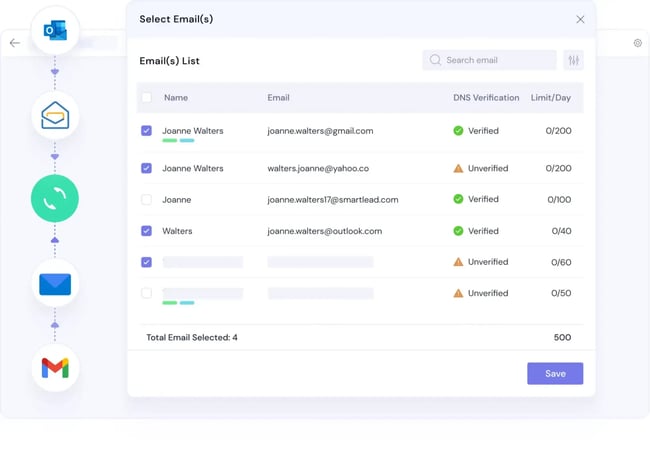
Smartlead.ai is a sales engagement platform designed to streamline and automate cold outreach efforts. The platform aims to enhance email deliverability and engagement through AI-driven personalization and dynamic IP rotation.
It offers features such as:
- Unlimited email accounts.
- Automated warm-ups.
- Multi-channel outreach capabilities, including email, SMS, LinkedIn, and WhatsApp.
- A unified inbox to manage all conversations in one place, facilitating efficient communication tracking and response.
The platform’s automation capabilities enable users to set up sequences with conditional logic, ensuring timely and relevant follow-ups based on recipient behavior.
Additionally, Smartlead offers robust analytics and reporting tools, providing insights into campaign performance metrics such as open rates, click-through rates, and conversions. These features collectively assist sales teams in optimizing their outreach strategies and improving overall efficiency.
4. Hunter.io

Hunter.io is a comprehensive email outreach platform designed to assist professionals in discovering and verifying email addresses, thereby streamlining lead generation and cold outreach efforts.
Its core functionalities include:
- Domain Search, which retrieves email addresses associated with a specific company domain.
- Email Finder, which identifies individual professional email addresses based on a person’s name and company.
- Email Verifier, which ensures the validity of email addresses, reducing bounce rates and enhancing deliverability.
Hunter’s Discover feature is also a great way to find companies that match your ideal customer profile. The platform caters to a diverse user base, including sales professionals, recruiters, marketers, and business owners.
Its pricing structure offers a free plan with limited searches and several paid tiers to accommodate varying needs and scales of operation. While the platform is lauded for its accuracy and user-friendly interface, the thing that’s kept me from personally exploring it is the lack of a direct LinkedIn integration.
5. Hublead
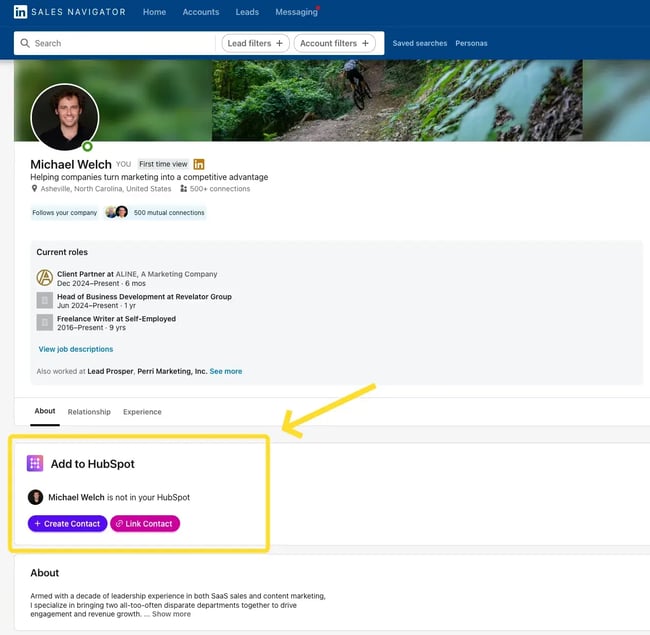
For cold emailers who rely on a combination of HubSpot and LinkedIn Sales Navigator, Hublead is an incredible tool that integrates the two platforms. Import LinkedIn contacts directly into HubSpot, enrich contact data, and even sync LinkedIn messages to the contact’s HubSpot record.
Finding Hublead saved me countless hours manually adding contacts and logging outreach, and it gave me much better visibility into the fruit of my LinkedIn outreach.
Pro tip: Build out HubSpot reports for metrics like connection requests sent, number accepted, message responses, and more to determine an ROI for outbound sales efforts on LinkedIn.
Cold Calling Tools
1. Aircall
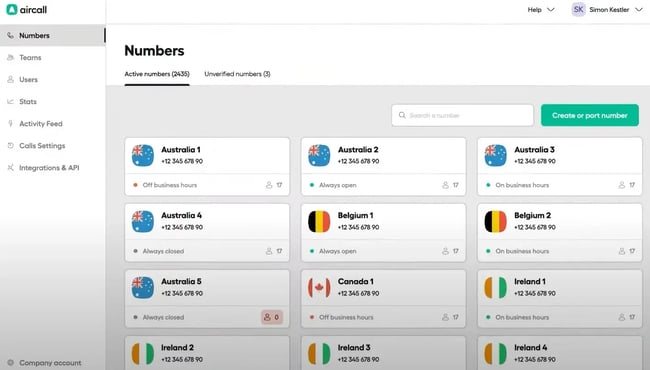
Aircall is a cloud-based phone system that caters to sales and support teams, offering a range of features to facilitate cold calling efforts. It provides a user-friendly interface with capabilities such as click-to-dial, call queuing, and real-time analytics. Aircall integrates with various CRM and helpdesk tools, allowing for seamless data synchronization and improved workflow.
I think one of Aircall’s strengths lies in its scalability and ease of deployment, making it suitable for teams of varying sizes. Its real-time analytics and call monitoring features can help managers oversee team performance and provide timely feedback.
I’ve used Aircall and found it to be pretty powerful, although my experience with the mobile app was a bit buggy.
2. RingCentral
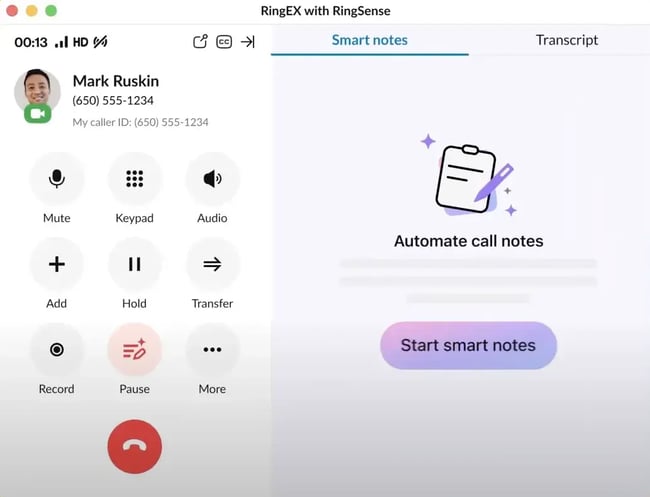
RingCentral is a unified communications platform that includes voice, video, messaging, and collaboration tools. For cold calling purposes, it offers features such as auto-dialing, call recording, automated note-taking, and CRM integration. RingCentral’s mobile and desktop applications enable sales teams to make and receive calls from various devices, supporting remote work scenarios.
The platform’s analytics and reporting tools provide insights into call volumes, durations, and outcomes, which can inform sales strategies. Its integration capabilities with CRM systems like HubSpot allow for efficient data management.
In my experience, RingCentral caters to larger organizations with more complex needs, meaning a smaller team focused strictly on cold calling might benefit from a more streamlined solution.
3. PhoneBurner
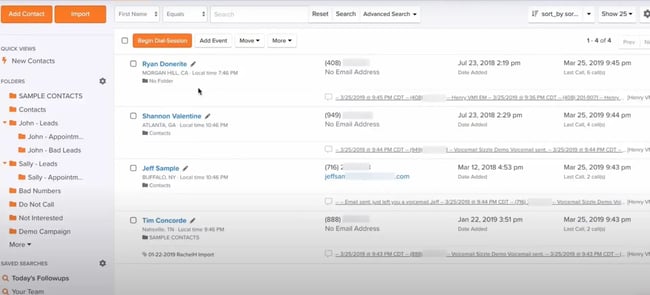
PhoneBurner is a power dialer and sales acceleration platform designed to increase outbound calling efficiency. It enables sales representatives to make calls without delays between connections, and it automatically logs activities and updates CRM records to save valuable time.
Features like voicemail drop help you combat low pickup rates, and it even sidesteps the cold email vs cold call debate by automating email follow-up.
The platform’s analytics dashboard provides performance metrics, helping managers identify high-performing agents and areas for improvement. PhoneBurner’s ease of use and integration with various CRMs make it accessible for teams looking to enhance their cold calling efforts.
However, its focus on phone-based outreach means that organizations seeking multi-channel engagement tools may need to supplement it with additional platforms. For teams prioritizing phone outreach and seeking to maximize call efficiency, PhoneBurner offers targeted features.
4. SalesLoft

SalesLoft is an all-in-one platform where sales teams can conduct and compare cold email vs cold call outreach in one place. Not only can reps make cold calls from within the tool, but all calls are also recorded and logged using SalesLoft’s Conversations feature for coaching and development opportunities.
Another notable feature of SalesLoft is the pre-recorded voicemail drop — no more leaving repetitive messages over and over.
The software also boasts an AI-powered “Rhythm” engine, which purports to analyze buyer signals and recommend the next best actions for sales reps. I haven’t had the opportunity to personally test out SalesLoft, but I’m certainly curious.
An Omnichannel Approach
Success in outreach comes down to understanding your audience and persistently delivering value. Cold calling and cold emailing don’t have to be an either/or choice — in fact, I’ve seen the best results when they work hand-in-hand.
You might initiate contact through a carefully crafted email, then follow up with a call referencing that note (or vice versa). By doing so, you create multiple touchpoints that reinforce your message and increase the likelihood of a connection.
I recommend keeping an eye on your metrics: If you notice your emails getting high open rates but low replies, maybe more calls are needed to engage those interested prospects. If your calls are going unanswered, perhaps your email can warm them up first or provide a reason to expect your call.
Finally, always be testing and iterating. Sales outreach is as much art as science. Track your cold email open and reply rates, note your cold call hit rates and call outcomes, and refine your approach as you learn. And remember, every “no” gets you closer to a “yes” when you’re committed to improving.
With the insights from this comparison and the tools and tips provided, I hope you’re well-equipped to craft a cold outreach strategy that turns strangers into prospects and prospects into customers. Good luck!
Editor's note: This post was originally published in June 2018 and has been updated for comprehensiveness.
Sales Prospecting


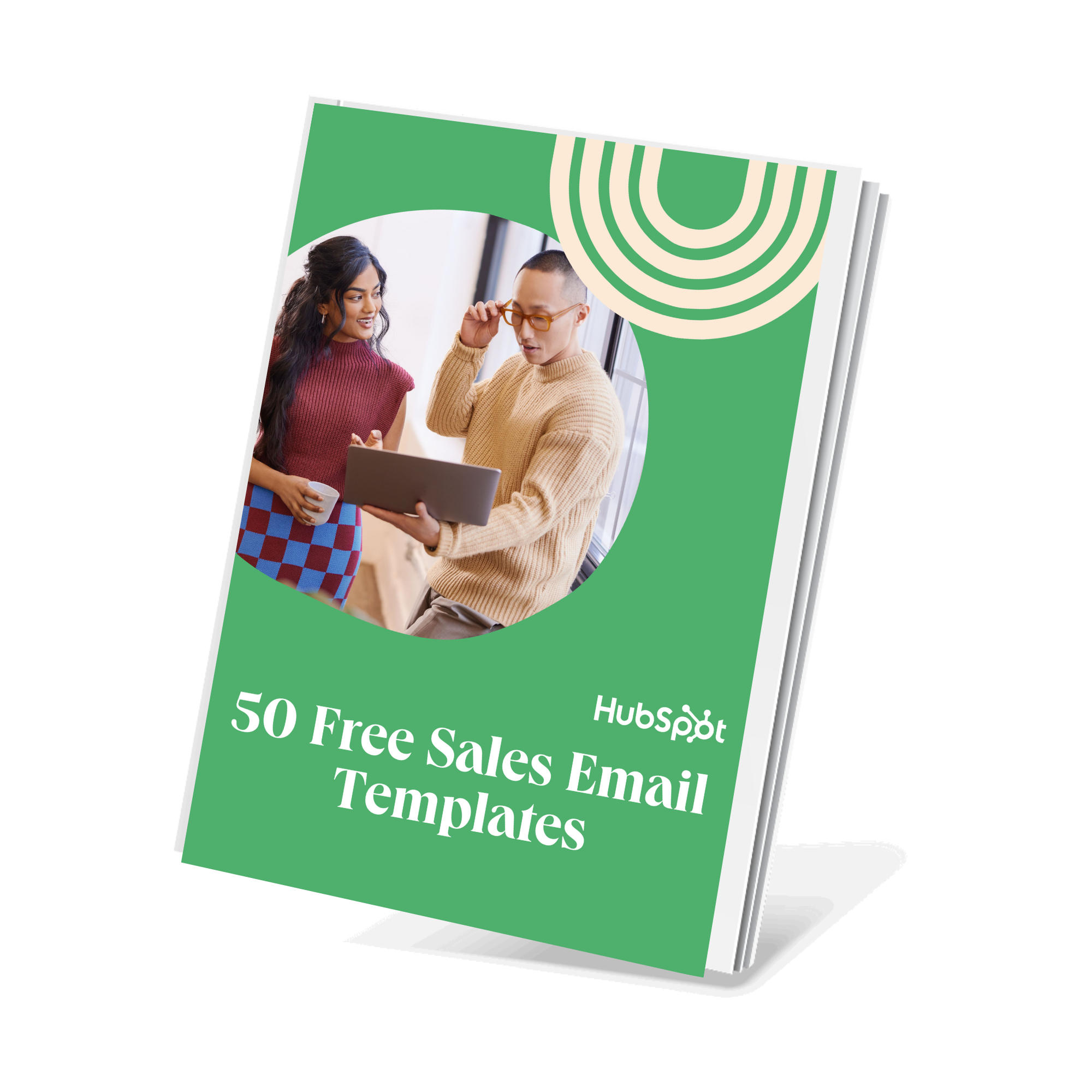
.webp)





![How to Find Almost Anyone’s Email Address, Without Being Creepy [+Expert Tips]](https://53.fs1.hubspotusercontent-na1.net/hubfs/53/132_Find%20Email%20Address.jpg)


